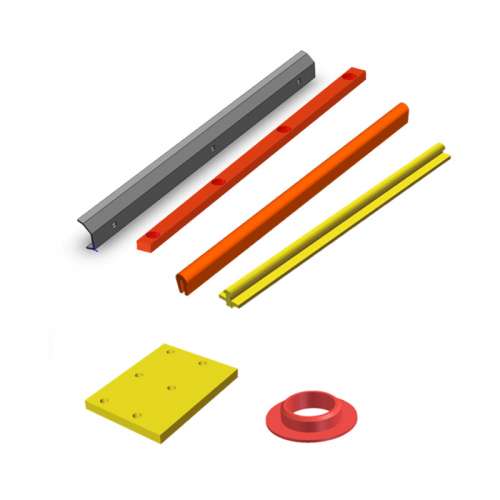- Client Services: +8613673237939
- Email: sales@mambascreens.com
Tension plate




Tension plate
For tensioning a wide range of screens, including woven screens with tensioning hooks and self-cleaning screens The triple bend design ensures effective tensioning of the screen on the curved screen frame The stiffness of the material allows the tension to be evenly distributed over the entire length of the hook, minimizing screen damage
Description
For tensioning a wide range of screens, including woven screens with tensioning hooks and self-cleaning screens.
The triple bend design ensures effective tensioning of the screen on the curved screen frame.
The stiffness of the material allows the tension to be evenly distributed over the entire length of the hook, minimizing screen damage.
Data provided:
A - Length
B - Distance from end to first hole (center)
C - Distance from first hole center to second hole center
D - Distance from second hole center to third hole center
E - Distance from third hole center to fourth hole center
F - Distance from fourth hole center to end
G - Height
Additional information
A "rubber-coated tension plate" is a device used for tensioning conveyor belts, playing a crucial role in adjusting, tensioning, and protecting the conveyor belt within a system. It is typically made of a metal plate covered with rubber, offering elasticity and wear resistance.
Main Features and Functions of Rubber-Coated Tension Plates:
Adjusting Tension: The rubber-coated tension plate can adjust the tension of the conveyor belt through an adjustment mechanism, ensuring the belt remains properly tensioned during operation to prevent slack or excessive tightness.
Protecting the Conveyor Belt: The rubber covering on the tension plate protects the conveyor belt's surface, reducing friction and wear from other components, thereby extending the belt's service life.
Reducing Noise and Vibration: The rubber-coated tension plate has vibration absorption and cushioning properties, which help to reduce noise and vibration generated during the operation of the conveyor system, enhancing the stability and comfort of the equipment's operation.
Strong Adaptability: Rubber-coated tension plates are highly adaptable and can be used in various conveyor belt systems, accommodating different types, specifications, and working conditions of conveyor belts.
Good Wear Resistance: The rubber coating on the tension plate offers good wear resistance, effectively resisting friction and wear on the conveyor belt's surface, and maintaining good operational condition.
Easy Installation and Maintenance: Typically designed with modularity in mind, rubber-coated tension plates are relatively easy to install and maintain. They can be quickly replaced and adjusted, reducing maintenance costs and downtime.
In summary, rubber-coated tension plates are essential components in conveyor belt systems. They provide the ability to adjust tension, protect the conveyor belt, reduce noise and vibration, exhibit strong adaptability and good wear resistance, and offer easy installation and maintenance. These features significantly enhance the operational efficiency and reliability of conveyor belt systems.
Characteristics of Rubber-Coated Tension Plates
Elasticity and Flexibility: The rubber coating provides the tension plate with a degree of elasticity and flexibility, allowing it to effectively adapt to changes in the conveyor belt surface and provide good contact and support.
Wear Resistance: The rubber coating offers excellent wear resistance, enabling the tension plate to withstand the friction and wear during the conveyor belt's operation, thus extending the lifespan of both the conveyor belt and the tension plate.
Tensile Strength: Typically made from high-strength metal substrates, rubber-coated tension plates possess good tensile strength, allowing them to endure the pulling forces and stresses during the belt tensioning process.
Corrosion Resistance: The metal substrate of the rubber-coated tension plate is usually treated for corrosion resistance, allowing it to operate stably in humid and corrosive environments over a long period.
Shock Absorption and Cushioning: The rubber coating has inherent shock absorption and cushioning properties, which help reduce vibrations and impacts generated during the operation of the conveyor belt system, enhancing operational stability and comfort.
Temperature Stability: The rubber coating can maintain stable performance within a specific temperature range, making it less susceptible to temperature variations and suitable for various working conditions.
Anti-Slip Properties: The surface of the rubber coating typically features an anti-slip design, increasing the friction with the conveyor belt surface and ensuring good contact between the tension plate and the belt.
Environmental and Safety Compliance: Rubber-coated tension plates are usually made from environmentally friendly materials that comply with relevant environmental standards and safety requirements, ensuring they do not pose any harm to the environment or human safety during use.
Summary
Rubber-coated tension plates are vital components in conveyor belt systems, offering a range of beneficial properties:
Elasticity and flexibility for effective adaptation and support.
Excellent wear resistance for extended lifespan.
High tensile strength to withstand tension forces.
Corrosion resistance for stable performance in harsh environments.
Shock absorption and cushioning for reduced vibrations and impacts.
Temperature stability for consistent performance.
Anti-slip design for enhanced contact with the conveyor belt.
Environmental and safety compliance for safe and eco-friendly operation.
These characteristics collectively improve the operational efficiency and reliability of conveyor belt systems.

Get Free Quote